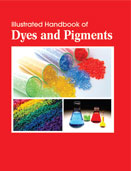Handbooks

This handbook covers the scientific and technical aspects of the chemistry and physics of dyes, pigments and their intermediates. Dyes and pigments are substances that impart color to a material. The term colorant is often used for both dyes (also called dyestuffs) and pigments. The major difference between dyes and pigments is the solubility. Pigments are generally not soluble in water, oil, or other common solvents. To be applied to a material, they are first ground into a fine powder and thoroughly mixed with some liquid, called the dispersing agent or vehicle. Pigments are used for coloring paint, ink, plastic, fabric, cosmetics, food, and other materials. Most pigments used in manufacturing and the visual arts are dry colorants, usually ground into a fine powder.
Dyes and pigments are substances that are used to impart color to liquid solutions and solid materials. These are used in almost every application. Perhaps there would be a very few applications, where there would be no use of the dyes. They have become indispensable tools for a variety of industries.
Illustrated Handbook of Dyes and Pigments provides the comprehensive overview of dyes and pigments and their related industries. For industrial applications, as well as in the arts, permanence and stability are desirable properties. Pigments that are not permanent are called fugitive. Fugitive pigments fade over time, or with exposure to light, while some eventually blacken. Pigments are used for coloring paint, ink, plastic, fabric, cosmetics, food, and other materials. Most pigments used in manufacturing and the visual arts are dry colorants, usually ground into a fine powder. This powder is added to a binder (or vehicle), a relatively neutral or colorless material that suspends the pigment and gives the paint its adhesion. Constant researches done over the 20th century and thereafter has resulted into every imaginable form of color of dye. Modern dyes serves more than just being pretty. They have become indispensable tools for a variety of industries. From acting as colorants for plastics, Textile dyeing industries and the highly sophisticated biotechnology industry dyes are touching our life everywhere. Dyes are also used by industries for inks and tinting. Today various dyes are manufactured to meet the requirements of each type of industries. Dyes are available in various forms. Examples are dry powders, granules, pastes, liquids, pellets, and chips. Dyes can be applied to materials in a variety of ways. The simplest approach is to dissolve the dye in water and then immerse the material within the dye solution.
A person who accidentally stains an item of clothing by spilling red wine on it has actually dyed it, although probably not as intended. Any dye that attaches itself to a material in this way is called a direct dye. The dye sticks to the material by forming chemical bonds that survive even after washing. Today the role and application of pigments have increased manifolds. There would hardly be any industries left where Pigments do not play any substantial role. The challenge is now to discover pigments that are capable of not only long-lasting applications but also are environmentally safe. Other industries where dyes are used in a variety of products include paper and pulp, adhesives, art supplies, beverages, ceramics, construction, cosmetics, food, glass, paints, polymers, soap, wax biomedicine etc. The Illustrated Handbook of Dyes and Pigments will be of use to students and researchers in diverse fields of activity such as cosmetics, reprographics, dye and pigment synthesis, medical research, polymers, etc.